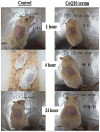Preparation and Evaluation of Complexed Ubiquinone (Coenzyme Q10) Antiaging Hyaluronic Acid-Vitamin C Serum for Skin Care
- PMID: 39739360
- PMCID: PMC11683515
- DOI: 10.1111/jocd.16706
Preparation and Evaluation of Complexed Ubiquinone (Coenzyme Q10) Antiaging Hyaluronic Acid-Vitamin C Serum for Skin Care
Abstract
Background: Coenzyme Q10 (CoQ10) is widely recognized for its powerful antioxidant properties, sparking considerable interest in its application within skincare treatments. However, its inherently poor water solubility has posed a major challenge in formulating effective skincare products.
Methods: This research aimed to develop and evaluate a water-soluble CoQ10 serum by forming a complex with hydroxypropyl β-cyclodextrin (HPβCD). The study focused on assessing its physicochemical properties, CoQ10 concentration, spread ability, viscosity, pH, physical stability, irritation potential, and diffusion performance. The complexation process was carried out using kneading and trituration techniques, with thorough characterization via validated analytical methods such as solubility tests, Fourier transform infrared spectroscopy (FTIR), and differential scanning calorimetry (DSC) analyses.
Results: The CoQ10-HPβCD complex prepared using the trituration technique at a 2:1 ratio (CoQ10 to HPβCD) demonstrated superior water solubility, reaching 17.5 ± 1.8 mg mL-1, the highest among the tested formulations. Moreover, this formulation achieved the greatest encapsulation efficiency, retaining 71% ± 3.8% of CoQ10. FTIR and DSC analyses confirmed the successful formation of the complex. The formulated serum exhibited shear-thinning behavior, an optimal pH of 4.3 ± 0.2 closely aligning with the skin's natural acidity for enhanced compatibility-along with excellent spreadability and stability. Diffusion tests revealed a significant enhancement in solubility when CoQ10 was complexed, effectively overcoming its solubility barrier. Irritation tests validated the serum's safety for topical use.
Conclusion: This study successfully developed a CoQ10 serum that overcame its solubility limitation, demonstrating favorable properties for skincare application. With its strong physicochemical characteristics and biocompatibility, this formulation shows significant promise for broader incorporation into skincare products.
Keywords: antiaging; coenzyme Q10; hyaluronic acid; skin care; ubiquinone.
© 2024 The Author(s). Journal of Cosmetic Dermatology published by Wiley Periodicals LLC.
Conflict of interest statement
The authors declare no conflicts of interest.
Figures









Similar articles
-
Optimization of nutraceutical coenzyme Q10 nanoemulsion with improved skin permeability and anti-wrinkle efficiency.Drug Dev Ind Pharm. 2018 Feb;44(2):316-328. doi: 10.1080/03639045.2017.1391836. Epub 2017 Nov 2. Drug Dev Ind Pharm. 2018. PMID: 29096550
-
Enhancing solubility and bioavailability of coenzyme Q10: formulation of solid dispersions using Soluplus® as a carrier.Arch Pharm Res. 2022 Jan;45(1):29-37. doi: 10.1007/s12272-022-01368-4. Epub 2022 Feb 7. Arch Pharm Res. 2022. PMID: 35128573
-
Enhanced Stability and Oral Bioavailability of Folic Acid-Dextran-Coenzyme Q10 Nanopreparation by High-Pressure Homogenization.J Agric Food Chem. 2018 Sep 19;66(37):9690-9696. doi: 10.1021/acs.jafc.8b02660. Epub 2018 Sep 6. J Agric Food Chem. 2018. PMID: 30141926
-
The Role of Coenzyme Q10 in Skin Aging and Opportunities for Topical Intervention: A Review.J Clin Aesthet Dermatol. 2024 Aug;17(8):50-55. J Clin Aesthet Dermatol. 2024. PMID: 39148958 Free PMC article. Review.
-
Coenzyme Q10: Novel Formulations and Medical Trends.Int J Mol Sci. 2020 Nov 10;21(22):8432. doi: 10.3390/ijms21228432. Int J Mol Sci. 2020. PMID: 33182646 Free PMC article. Review.
References
MeSH terms
Substances
LinkOut - more resources
Full Text Sources
Medical

